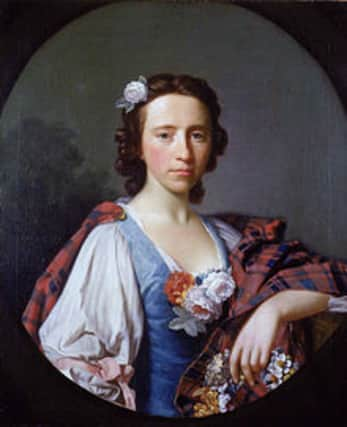Flora MacDonald - Highland rebel and Jacobite heroine


She had known Bonnie Prince Charlie for only 10 days and spent time in his company for just a small portion of that.
But since helping the beleaguered Prince to flee Scotland dressed as a woman in the summer of 1746, MacDonald has been held up as the ultimate - and certainly the most famous - Jacobite heroine.
Advertisement
Hide AdAdvertisement
Hide AdHer arrest and imprisonment turned this unlikely, mild mannered rebel into the stuff of legend, with the farmer's daughter from Milton on Skye immortalised in song, portraiture and bronze.
MacDonald's accompaniment of the prince, dressed in a petticoat, calico dress and large hood, in a rowing boat across the Minch is perhaps one of the most romanticised and enduring episodes of the failed Stuart rising.
But still what pushed her to get involved in the plot remains unclear, particularly given she had not shown allegiance to any side during the rebellion. Alarmed at the poor state of the Prince, she claims to have acted out of charity, even telling the Duke of Cumberland that she would have done the same for him had he been in the same way.
Maggie Craig, author of Damn Rebel Bitches, Women of the ‘45, wrote: “Much has been written about Flora MacDonald.
“Very little of it makes it any easier to get at her personality or understand her motives. She comes through all the verbiage as curiously passive, a blank page on which everyone else has written their own interpretation of her life and character.”
The courage of the 24-year-old,, however, speaks for itself with the escape arranged as 2,000 government redcoats searched for the fugitive Prince, who had a £30,000 bounty on his head.
Flora’s step father, Hugh MacDonald, a Hanoverian officer with underlying Jacobite sympathies, may have been the mastermind behind the elaborate escape plan, according to various accounts.
She was approached by Jacobite captain Felix O’Neil, and then the Prince, at a sheiling near Ormacleit in South Uist, where her brother had asked her to mind some sheep.
Advertisement
Hide AdAdvertisement
Hide AdO’Neil in her request for help pitched the “the honour and immortality that would redound to her by such a glorious action.”
It really was quite the offer.
After Charles Edward Stuart asked directly for her help-, Flora agreed. The ease at which she accepted the request varies by degrees. She either “joyfully” signed up or was horrified at the thought of it, depending who you read.
As preparations got underway, MacDonald and Lady Clanranald helped to stitch the outfit for the Prince, who was to be taken to the home of MacDonald of Sleat at Monkstadt, near Uig, on Skye and then moved from Portree to Raasay.
After arriving at Skye, the group were moved on to Kingsburgh to stay at the home of Alexander Macdonald. the estate factor.
Flora was to later marry his son, Allan, a government soldier, with the couple having seven children.
After the Prince was moved off Skye, information quickly started to gather against Flora, who was arrested on July 12 1746, less than two weeks after she left Charles.
Flora was held in captivity for almost a year - first on HMS Bridgewater moored at Leith then in London, but, like many women arrested following Culloden, was treated better than an ordinary prisoner. She was allowed to stitch clothes and receive visitors
In Flora’s case, her handling may have been linked to her willingness to comply with her captors.
Advertisement
Hide AdAdvertisement
Hide AdHer statement, given at Applecross Bay, on July 12 1746, details the main players and locations in the plot.
After bring transferred to London on the HMS Bridgewater in December, she became somewhat of a celebrity, according to Craig. A collection of £1,500 was raised for her by Lady Primrose, a Jacobite, at her house in the Strand where Flora had been permitted to visit during her custody.
She was freed as part of the Act of Indemnity in July 1747 and returned first to Edinburgh, then Skye for a short spell, then back to London, where she sat for portrait artist Allan Ramsay, one of the most prominent portrait artists of the day.
She married in 1750 and settled on Skye before emigrating to North Carolina where her husband fought for the British Government with the Royal Highland Emigrants. He was imprisoned for two years but the family eventually returned to Skye. Flora suffered poor health in later life and died in 1790 aged 69.
More than 3,000 people are said to have attended her funeral.
Her stone at Kilmartin is inscribed with the words of James Boswell, who met her on his tour of the Highlands,
It reads: “Her name will be mentioned in history and if courage and fidelity be virtues, mentioned with honour.”